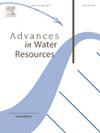Pore-scale investigations of particle migration by fluid–particle interactions in immiscible two-phase flow systems: A three-dimensional X-ray microtomography study
IF 4.2
2区 环境科学与生态学
Q1 WATER RESOURCES
引用次数: 0
Abstract
Understanding of particle migration by fluid–particle interactions in immiscible two-phase flow systems in porous media is crucial for subsurface applications. However, pore-scale investigations of particle migration in immiscible two-phase flow systems remain limited for three-dimensional (3D) porous media because of the complexities of fluid flow in such media. Here, we employed microfocus X-ray computed tomography (CT) to investigate the effects of interfacial tension and viscous force on particle migration during fluid–particle interactions in strong drainage and imbibition for the pore-scale process. A mixture of two differently sized particles was used as a 3D heterogeneous porous medium. The experimental conditions cover the logarithmic values of the capillary number (LogCa) range between −7.476 and −4.777 and of a fixed viscosity ratio (LogM) of −0.867, which are used to simulate the carbon dioxide (CO2) sequestration. The results show that particle migration significantly proceeded throughout the medium for strong drainage compared to strong imbibition. At a low injection flow rate or LogCa, interfacial tension strongly influenced particle accumulation, altering pore networks. The combined effects of interfacial tension and viscous force enhanced particle migration with an increase in LogCa. In strong drainage, the particles migrated with the interface expansion between the two phases. However, in strong imbibition, they were displaced along with the fluid flow because of the presence of film formations. The findings of this study improve the understanding of particle migration by fluid–particle interactions under different injection flow rates and wettability conditions in 3D heterogeneous porous media.

非混相两相流系统中流体-颗粒相互作用对颗粒迁移的孔隙尺度研究:三维x射线微断层扫描研究
了解多孔介质中非混相两相流系统中流体-颗粒相互作用对颗粒迁移的影响对地下应用至关重要。然而,由于三维(3D)多孔介质中流体流动的复杂性,对非混相两相流体系中颗粒迁移的孔隙尺度研究仍然有限。本研究采用微聚焦x射线计算机断层扫描(CT)研究了强排水和强吸吸过程中流体-颗粒相互作用过程中界面张力和粘性力对颗粒迁移的影响。两种不同大小的颗粒的混合物被用作三维非均质多孔介质。实验条件为毛细管数LogCa(- 7.476 ~ - 4.777)和固定粘度比LogM(- 0.867)的对数,用于模拟二氧化碳(CO2)的固存。结果表明,在强排水条件下,颗粒在介质中的迁移明显大于强吸吮条件。在低注入流速或LogCa时,界面张力强烈影响颗粒积聚,改变孔隙网络。界面张力和粘滞力的共同作用增强了颗粒的迁移,同时增加了LogCa。在强排水条件下,颗粒随着两相界面的扩展而迁移。然而,在强吸胀条件下,由于膜层的存在,它们随着流体的流动而被置换。本研究的发现提高了对三维非均质多孔介质中不同注入流速和润湿性条件下流体-颗粒相互作用下颗粒迁移的认识。
本文章由计算机程序翻译,如有差异,请以英文原文为准。
求助全文
约1分钟内获得全文
求助全文
来源期刊

Advances in Water Resources
环境科学-水资源
CiteScore
9.40
自引率
6.40%
发文量
171
审稿时长
36 days
期刊介绍:
Advances in Water Resources provides a forum for the presentation of fundamental scientific advances in the understanding of water resources systems. The scope of Advances in Water Resources includes any combination of theoretical, computational, and experimental approaches used to advance fundamental understanding of surface or subsurface water resources systems or the interaction of these systems with the atmosphere, geosphere, biosphere, and human societies. Manuscripts involving case studies that do not attempt to reach broader conclusions, research on engineering design, applied hydraulics, or water quality and treatment, as well as applications of existing knowledge that do not advance fundamental understanding of hydrological processes, are not appropriate for Advances in Water Resources.
Examples of appropriate topical areas that will be considered include the following:
• Surface and subsurface hydrology
• Hydrometeorology
• Environmental fluid dynamics
• Ecohydrology and ecohydrodynamics
• Multiphase transport phenomena in porous media
• Fluid flow and species transport and reaction processes
 求助内容:
求助内容: 应助结果提醒方式:
应助结果提醒方式:


